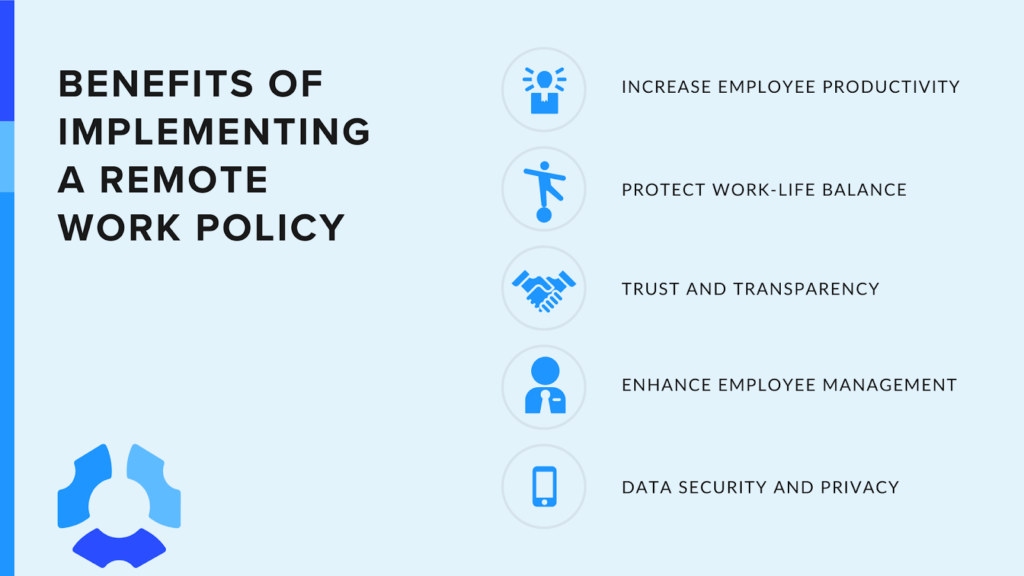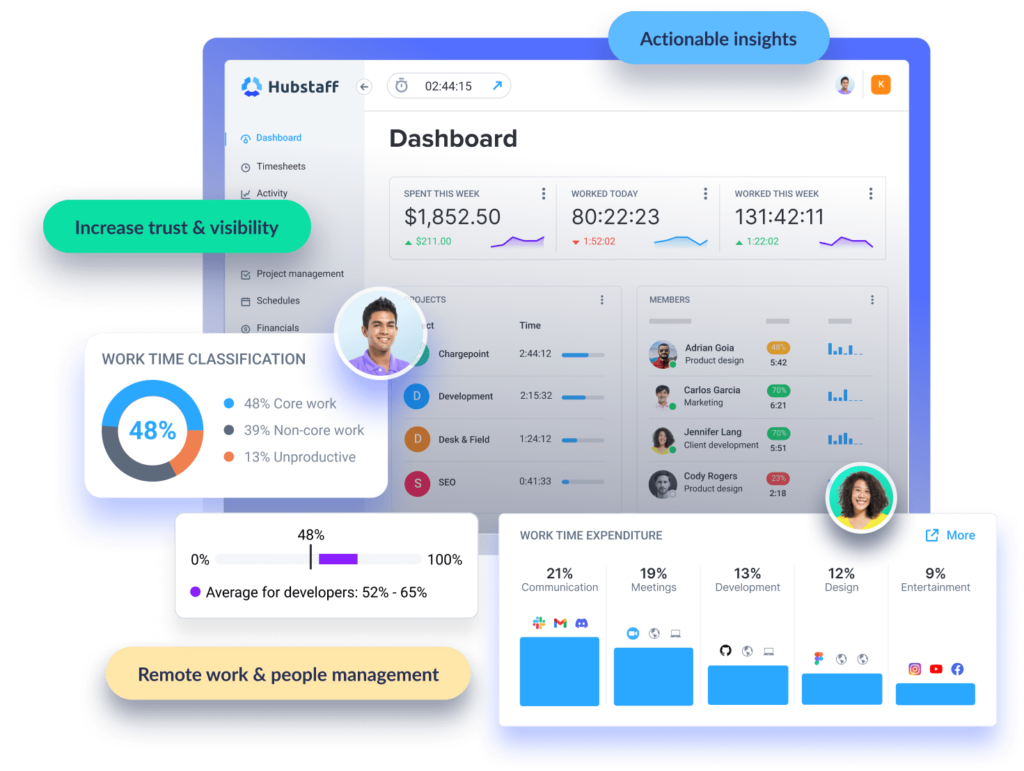

It seems remote work is here to stay — with predictions that 32.6 million Americans will work remotely by 2025. If your company has employees working from home, it’s essential to have a remote work policy in place to outline expectations and ensure that remote workers stay aligned with company goals.
In this guide, we explore what a remote work policy is and the benefits of having one in your company. We also look at best practices and rules for employees to follow. Most importantly, we’ll provide you with a template you can use so you don’t have to start from scratch.
In a rush? No worries; here is a link to our Remote Work Policy Template to download and customize it quickly.
With that said, let’s dive in to uncover the steps to build a remote work policy tailored to your business needs and culture.
A remote work policy establishes guidelines for employees to conduct business outside traditional on-site offices. Also referred to as work-from-home or telecommuting policies, these frameworks codify best practices surrounding off-site work arrangements to nurture productivity while protecting company interests.
Well-constructed remote policies outline factors intended to build success for remote teams, including:
Remote work policies vary widely, and a remote work policy acts similarly to an employee handbook, clearly dictating expectations for employees who work from home.
Let’s start by exploring the benefits of remote work policies.
Implementing a clearly defined remote work policy offers myriad upsides for businesses embracing flexible working arrangements.

As you can see, instituting clear remote work policies yields impressive benefits for managers and employees.
In other words, everyone benefits from a solid remote work policy.
With that said, let’s take a look at what an effective remote work policy should include.
Below, we look at the most essential elements of a remote work policy. We’ll divide them into two categories:
This way, it will be easier for you to clarify what remote work entails and what is expected from employees, as well as outline the criteria for eligibility and the scope of the remote work policy.
Your organization’s remote work policy should define distributed work arrangements that enable staff to conduct regular job duties from home offices.
Expectations within these flexible policies should aim to empower employees with increased autonomy over scheduling and location while establishing helpful communication expectations, security protocols, and productivity management.
By balancing empowerment and accountability, your remote policies will help all remote employees thrive through structured guidelines.
The policy should also clarify that managers and employees are expected to embrace a culture of transparent dialogue to clarify the company’s support for mutual trust.
The remote work policy should outline the criteria for eligibility and the scope of remote work within your organization.
Eligibility typically considers certain factors to determine who qualifies for remote work. For example, it might include things such as
The scope addresses expectations, communication protocols, and technology requirements for remote employees. It may specify additional criteria to ensure productivity and collaboration, including
Additionally, the policy may detail data security and confidentiality measures to protect sensitive information. You must also have clear guidelines on equipment, internet connectivity, and virtual collaboration tools.
Establishing a well-defined remote work policy fosters a transparent and supportive work environment, balancing flexibility with organizational goals.
These fundamental elements will give you a comprehensive framework that you can then use to develop your remote work policy.
Now that you understand what a remote work policy should include download our free template to help make your work easier.

Note that these policies are usually comprised of multiple pages. Yours may be longer or shorter depending on the industry and scope of the company.
No remote work policy works for all businesses. The foundation of an effective remote work policy begins with a template that outlines all the essential components tailored to your organization’s specific needs.
With that said, here are detailed instructions to help you create a comprehensive, thoughtfully constructed template that ensures consistency, structure, and transparency in your company’s remote work strategy.

Decide which groups of employees qualify for remote work based on factors like role, tenure, past performance, and suitability. You can start slowly with specific teams or open up eligibility widely from the start. Clearly outline eligibility criteria in your policy. Consider elements like a reliable internet connection and virtual private networks (VPNs).
Remote work allows flexibility and set standards for typical work hours and locations. You can require employees to work in a home office location or allow work from anywhere. Outline core hours where you expect availability for team meetings and collaboration.
Provide guidance around preferred communication channels, such as Gmail, Slack, or similar apps, and expectations for response time and accessibility. For example, one requirement you can add is checking and responding to emails or messages within a specific window.
Define how productivity and work output will be measured through quantifiable metrics and goals unique to each role. Make sure to outline the required frequency for sending progress reports to managers.
Specify what equipment, software, and tech support will be supplied by the company for employees working remotely. Set rules regarding access restrictions and cybersecurity practices. Outline any stipends, reimbursements, or purchase policies you will provide remote employees with. Consider factors like electricity and internet bills and home office setup.
Provide information on any mandatory data security, customer privacy, and confidentiality training. Establish procedures for reporting data breaches and ensure protocols adhere to regulations. Clarify the expected use of a virtual private network.
Specify what work-related expenses are covered if employees furnish their own remote office space and supplies. Clearly outline what can be expensed and the process for reimbursement requests.
This step involves aligning carryover vacation, sick days, and holiday policies from the office environment to remote work. Be sure to define procedures for requesting and reporting time off.
Once you’ve completed these steps, you’ll have a comprehensive remote work policy that protects your business and established transparent guidelines for remote employees. Now, it’s time to implement this policy.
Here are some best practices for effectively implementing a remote work policy in your organization:
Involving staff in shaping successful remote operations while ensuring supportive infrastructure is in place enables smoother adoption and consistently reinforces your organization’s policy over the long term.
Managing a remote team can seem daunting. Luckily, tools like Hubstaff and other workforce management software are invaluable in helping you enforce and manage the critical aspects of your remote work policies.

Here are a few things Hubstaff can help remote teams with:

While Hubstaff doesn’t enforce policies directly, its employee activity metrics arm managers with better visibility and insights to ensure adherence.
Setting clearly defined “healthy” productivity thresholds and goals upfront aligns remote staff with policy expectations. The data can prompt action plans to correct any non-compliance through coaching.
Finally, we’d be remiss if we didn’t remind you that, regardless of the type of policy you’re creating, it’s essential to understand the legal and ethical aspects.
Here are some fundamental legal and ethical considerations when constructing remote work policies for your organization:
Understanding the laws and regulations for an entire dispersed team will take time. But naivety around regulations is unacceptable and unethical. If you’re unsure, seek expertise to ensure the integrity of your policy.
Here’s a quick summary of what is outlined in this guide on creating an effective remote work policy:
Are you ready to implement a remote work policy in your organization? By now, we’re confident you have the template, tools, and information you need to pull this off successfully.
 Ron Stefanski
Ron Stefanski Ron Stefanski is a website entrepreneur and marketing professor who has a passion for helping people create and market their own online business. You can learn more from him by visiting OneHourProfessor.com.
We’ve all experienced the helpless feeling of work overload. What’s worse is that the perils of overwork are well-documented.
Weekly Employee Status Report Templates: Free Downloads and Examples At Hubstaff, staying informed about your team’s p.
By 2030, the US alone will lose $430 billion annually due to low talent retention — and a lot of this turnover stems from low pa.
It’s hard to believe that only a century ago, the 80-hour work week was the norm in the United States. Then, in 1926, the Ford M.
Set limits, turn tracked time into automated timesheets, and send invoices with Hubstaff.